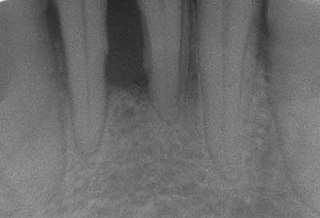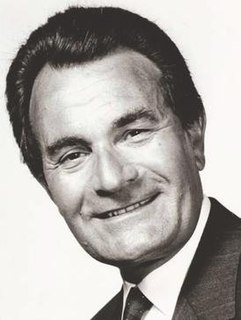
Periodontal disease, also known as gum disease, is a set of inflammatory conditions affecting the tissues surrounding the teeth. In its early stage, called gingivitis, the gums become swollen, red, and may bleed. In its more serious form, called periodontitis, the gums can pull away from the tooth, bone can be lost, and the teeth may loosen or fall out. Bad breath may also occur.

The periodontal ligament, commonly abbreviated as the PDL, is a group of specialized connective tissue fibers that essentially attach a tooth to the alveolar bone within which it sits. It inserts into root cementum one side and onto alveolar bone on the other.
Periodontology or periodontics is the specialty of dentistry that studies supporting structures of teeth, as well as diseases and conditions that affect them. The supporting tissues are known as the periodontium, which includes the gingiva (gums), alveolar bone, cementum, and the periodontal ligament. A periodontist is a dentist that specializes in the prevention, diagnosis and treatment of periodontal disease and in the placement of dental implants.
Dental plaque is a biofilm of microorganisms that grows on surfaces within the mouth. It is a sticky colorless deposit at first, but when it forms tartar, it is often brown or pale yellow. It is commonly found between the teeth, on the front of teeth, behind teeth, on chewing surfaces, along the gumline, (supragingival) or below the gumline cervical margins (subgingival). Dental plaque is also known as microbial plaque, oral biofilm, dental biofilm, dental plaque biofilm or bacterial plaque biofilm. Bacterial plaque is one of the major causes for dental decay and gum disease.
Laser-assisted new attachment procedure (LANAP) is a surgical therapy for the treatment of periodontitis, intended to work through regeneration rather than resection. This therapy and the laser used to perform it have been in use since 1994. It was developed by Robert H. Gregg II and Delwin McCarthy.

Gingivitis is a non-destructive disease that causes inflammation of the gums. The most common form of gingivitis, and the most common form of periodontal disease overall, is in response to bacterial biofilms that is attached to tooth surfaces, termed plaque-induced gingivitis. Most forms of gingivitis are plaque-induced.
Hessam Nowzari is the Director of the University of Southern California Advanced Periodontics program, since 1995, and is a Diplomate of the American Board of Periodontology.
Epidemiology of periodontal disease is the study of patterns, causes, and effects of periodontal diseases. Periodontal disease is a disease affecting the tissue surrounding the teeth. This causes the gums and the teeth to separate making spaces that become infected. The immune system tries to fight the toxins breaking down the bone and tissue connecting to the teeth to the gums. The teeth will have to be removed. This is an advance stage of gum disease that has multiple definitions. Adult periodontitis affects less than 10 to 15% of the population in industrialized countries, mainly adults around the ages of 50 to 60. The disease is now declining world-wide.
Aggressive periodontitis describes a type of periodontal disease and includes two of the seven classifications of periodontitis as defined by the 1999 classification system:
- Localized aggressive periodontitis (LAP)
- Generalized aggressive periodontitis (GAP)
Preston D. Miller, Jr. is a periodontist.
Hom-Lay Wang (王鴻烈) is a Taiwanese-born periodontist and director of the graduate periodontal program at University of Michigan School of Dentistry.
The Department of Periodontology is a division of the University of Connecticut School of Dental Medicine Department of Oral Health and Diagnostic Sciences. It carries out research and offers training for pre-doctoral and postgraduate students.
The European Federation of Periodontology (EFP) is a non-profit, scientific dental organisation, comprising 25 National Periodontal member Societies in Europe. It currently numbers 14000 members approximately. Full members: Austrian Society of PeriodontologyAustrian Society of Periodontology, Belgian Society of PeriodontologyBelgian Society of Periodontology, British Society of PeriodontologyBritish Society of Periodontology, Croatian Society of PeriodontologyCroatian Society of Periodontology, Czech Society of PeriodontologyCzech Society of Periodontology, Danish Society of PeriodontologyDanish Society of Periodontology, Dutch Society of PeriodontologyDutch Society of Periodontology, Finnish Society of PeriodontologyFinnish Society of Periodontology, French Society of Periodontology and Oral ImplantologyFrench Society of Periodontology and Oral Implantology, German Society of PeriodontologyGerman Society of Periodontology, Hellenic Society of PeriodontologyHellenic Society of Periodontology, Hungarian Society of PeriodontologyHungarian Society of Periodontology, Irish Society of PeriodontologyIrish Society of Periodontology, Israeli Society of Periodontology and OsseointegrationIsraeli Society of Periodontology and Osseointegration, Italian Society of PeriodontologyItalian Society of Periodontology, Norwegian Society of PeriodontologyNorwegian Society of Periodontology, Portuguese Society of Periodontology, Slovenian Society of Periodontology, Spanish Society of Periodontology and OsseointegrationSpanish Society of Periodontology and Osseointegration, Swedish Society of PeriodontologySwedish Society of Periodontology, SwissSociety of PeriodontologySwiss Society of Periodontology, Turkish Society of PeriodontologyTurkish Society of Periodontology . Associate members: Moroccan Society of Periodontology and ImplantologyMoroccan Society of Periodontology and Implantology, Polish Society of PeriodontologyPolish Society of Periodontology, Serbian Society of PeriodontologySerbian Society of Periodontology.
The American Academy of Periodontology (AAP) is the non-profit membership association for periodontists-dental professionals specializing in the prevention, diagnosis, and treatment of diseases affecting the gums and supporting structures of the teeth and in the placement and maintenance of dental implants.
Gary Greenstein is an American periodontist known for his scholarship and contribution to evidence-based periodontal and dental implant literature.
Brian Mealey is an American periodontist.
Jørgen Slots is a Danish-born periodontist notable for his contributions to the field of periodontology. He is currently professor of periodontology and microbiology at the Herman Ostrow School of Dentistry of USC, and served as chairman of periodontology from 1991 to 2001.

John Saville Zamet FDS was a periodontist in the United Kingdom. He established the first exclusively periodontal practice in London in 1966.
Kaumudi Jinraj Joshipura is an Indian American Epidemiologist, Biostatistician, Dentist & Scientist. She is Adjunct Full Professor at Harvard T.H. Chan School of Public Health (HSPH) at Harvard University and NIH Endowed Chair and Director of the Center for Clinical Research and Health Promotion and a Full Professor at the University of Puerto Rico, Medical Sciences Campus. Her research work has been covered by global media including CNN, ABC, NBC, NHS, Newsweek, Nature, Telegraph, Japanese Journals and Japanese TV etc.



